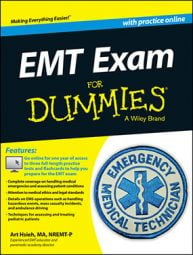On the EMT Exam, you will be faced with multiple choice questions. A multiple-choice question, or item, is made of several parts: the stem, distractors, and the correct answer. Each part plays a specific role.
The stem
The stem is the “question” part of the item. It’s the first part that sets up the situation for you to respond to, providing only the information necessary for you to answer the item correctly. The stem ends in the form of a question, for example, “What should you do next?” or asks you to complete a statement, such as “You suspect the underlying condition to be… .”
Here’s an example of a stem: “An adult male is unresponsive on the floor of a restaurant. Patrons report the patient was having lunch when he suddenly grabbed his throat and collapsed. He is cyanotic, with agonal breaths. What should you do next?”
Distractors and the answer
The choices that are provided after the stem come in two flavors, answers and distractors. The answer is the best choice, given the stem. A distractor is exactly that — it’s designed to draw your attention away from the answer.
Note the importance of high-quality distractors
Where a multiple-choice question shines is in the quality of the distractors. Good distractors look like they could be right answers. In fact, they often are; however, in such cases the stem asks for the best answer, not the right one. This means that you really have to choose which “right” answer is the best one.
On the other hand, bad distractors are obviously incorrect. Bad distractors don’t test your knowledge base or your ability to reason. Here’s a simple example.
You look up and see a small animal with wings flying overhead. As it does, you can hear it make a “quack quack quack” sound. You suspect it is
(A)a cow.
(B)a dog.
(C)a duck.
(D)a brick.
Unless you’ve been partaking in some sort of mind-altering substance, you immediately recognize that Choices (A), (B), and (D) aren’t even remotely described by the stem. This question really doesn’t evaluate knowledge — the distractors are so off the mark that Choice (C) is the only possible answer.
What if the choices were these instead?
(A)an American Black Duck.
(B)a Tufted Duck.
(C)a Ruddy Duck.
(D)a Steller’s Eider.
Unless you’re a duck aficionado, this question is much more difficult to answer. All the distractors are of the duck variety. Three of the choices include the word “duck.” You’d need to know something about ducks to answer this question correctly. (And in case you want to really know, it’s the American Black Duck; the others don’t quack.
For example, the Tufted Duck makes a “kar kar” sound, and the Ruddy Duck makes a low belching sound — quite rude, those Ruddy Ducks. But you get the point: You need to know this information to answer the question.)
Aim for the best answer
The NREMT exam asks you to select the best answer from the choices. Don’t mistake “best” with “right.” On the exam, more than one of the distractors may be right. The more right answers you have to select from, the harder the question is to answer.
An adult male is unresponsive on the floor of a restaurant. Patrons report the patient was having lunch when he suddenly grabbed his throat and collapsed. He is cyanotic, with agonal breaths. What should you do next?
(A)Perform abdominal thrusts.
(B)Perform chest compressions.
(C)Roll him onto his side.
(D)Ventilate with a pocket mask.
Given the situation described in the scenario, most of these answers are correct. But, the stem is asking for what to do next. Here are some factors you need to consider:
Cyanosis with agonal breathing makes you conclude that the patient is in cardiac arrest, which requires chest compressions, Choice (B), as soon as possible.
You need to recognize that abdominal thrusts, Choice (A), are performed only if a patient is conscious and obstructed, not when he’s unconscious.
Ventilation, Choice (D), comes after chest compressions.
Rolling the patient onto his side, Choice (C), won’t change the state of the patient.
So, although Choices (B) and (D) are both appropriate in cardiac arrest, the best choice is (B).
You may be thinking, “Wait! There’s no information about whether the patient has a pulse. How do I know that he’s in cardiac arrest?” The step of checking for a carotid pulse isn’t a choice. You need to know that agonal respirations set in at the beginning of cardiac arrest.
Answering NREMT exam items is similar to the real-life decision-making you’ll do in the field. Based on limited findings and your knowledge base, you’ll need to make some conclusions about the patient and then use those to decide what to do about the situation.

